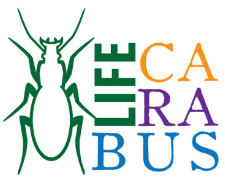CARABUS - Protecting and conserving the habitats of species for the consolidation of the population of Carabus olympiae in Val Sessera
LIFE11 NAT/IT/000213

Object
Catching and in situ breeding of Carabus olympiae.
Objective
To identify a protocol for the in-situ breeding of Carabus olympie in order to carry out its reintroduction in the wild.
Good Practice Description
This good practice is divided into 3 main moments:
- non-invasive catching of adult specimens with double bottom pitfall traps;
- breeding at the laboratory of captured individuals to observe their biological and reproductive cycles;
- release of newly emerged adults in the intervention areas
For the catching, pitfall traps are used, which are double-bottomed plastic cups in polypropylene, primed with vinegar, buried up to the brim, and covered with a medium-sized flat stone. The traps were positioned in groups of 5 at previously identified and georeferenced sampling points. Traps should be checked approximately every four days. Once captured and registered, the adults are put in couples in labelled containers (to find out the number of the couple and of the single individuals) in a special on-site nursery set up for this purpose.
Each phase of the biological cycle, from the eggs’ phase to the emergence of adults, has its own procedures and requires special attention, it is necessary to have the environmental conditions monitored by a data logger for temperature and humidity. Once adults are ready to be reintroduced into nature, if it is needed to monitor them and evaluate the best habitats, it is possible to radiolabel them, as was the case in the project.
Territorial Context
The project was carried out in SIC IT1130002 “Val Sessera”, established above all for the protection of the Carabus. It is an area mainly characterised by beech woods and encroachment at the thicket levels, with some areas artificially reforested with conifers (spruce, larch and exotic). An important role is also played by pastures and prairies.
Replicability conditions
This good practice requires having a structure with a nursery function, with equipment to constantly monitor the temperature and humidity of the room, and staff continuously present. It is a practice that can also be used for other species of Carabus at risk of extinction, by adapting the parameters of acclimatization of the species.
Dissemination material
From the LIFE GoProFor database, in the final part of the sheet, it is possible to download both technical and informative material relating to the project, especially Layman's report and the technical-scientific report of action D2 "Breeding of Carabus olympiae and follow-up of reintroduced individuals".


